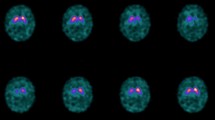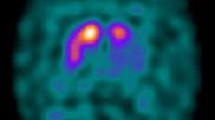Abstract
123I-FP-CIT-SPECT is useful in the differential diagnosis of Parkinson’s disease (PD) and tremor syndromes. Recently, there have been reports on normal nigrostriatal uptake of radio ligands in PD patients, referred to as scans without evidence of dopaminergic deficit (SWEDDs). Furthermore, a dopaminergic deficit has been described in some cases of different tremor types. We sought to clarify the occurrence of SWEDDs in PD and a possible association of various tremor types with PD. We performed a retrospective case analysis of 125 patients with diagnostically uncertain Parkinsonian or non-Parkinsonian tremor syndromes with clinical assessments and 123I-FP-CIT-SPECT. A total of 36/40 (90%) patients with the predominant clinical feature of a postural and/or kinetic tremor showed normal DAT SPECT; 73/85 (86%) with predominant clinical symptoms of PD showed abnormal DAT SPECT with lower overall radio ligand uptake and a significant asymmetry contralateral to the clinically more affected side. In all, 4/40 (10%) of non-Parkinsonian tremor patients had abnormal DAT SPECT, but no corresponding asymmetry of radio ligand uptake. Probable essential tremor was considered clinically in follow-up assessments although final diagnosis of these four tremor cases remains inconclusive. A total of 12/85 (14%) clinically suspected PD patients had normal DAT SPECT (SWEDDs). Clinical reassessment identified two patients with dystonic tremor. Five patients with a positive response to levodopa remained unclear. In four cases of suspected PD with normal DAT SPECT, non-neurologic diseases were identified. One case showed a complete and spontaneous remission of symptoms. DAT SPECT offers an objective method to confirm or exclude a dopaminergic deficit in tremor predominant parkinsonism for clinically inconclusive cases. There was no evidence of a decrease in DAT binding in the majority of patients with postural and/or kinetic tremor. The striatal asymmetry index is a further helpful tool for differentiating PD from non-PD tremor syndromes.
Similar content being viewed by others
References
Booij J, Hemelaar TG, Speelman JD, de Bruin K, Janssen AG, van Royen EA (1999) One-day protocol for imaging of the nigrostriatal dopaminergic pathway in Parkinson’s disease by [123I]FPCIT SPECT. J Nucl Med 40:753–761
Antonini A, Benti R, De Notaris R et al (2003) 123I-Ioflupane/SPECT binding to striatal dopamine transporter (DAT) uptake in patients with Parkinson’s disease, multiple system atrophy, and progressive supranuclear palsy. Neurol Sci 24:149–150
Benamer TS, Patterson J, Grosset DG et al (2000) Accurate differentiation of parkinsonism and essential tremor using visual assessment of [123I]-FP-CIT SPECT imaging: the [123I]-FP-CIT study group. Mov Disord 15:503–510
Catafau AM, Tolosa E (2004) Impact of dopamine transporter SPECT using 123I-Ioflupane on diagnosis and management of patients with clinically uncertain parkinsonian syndromes. Mov Disord 19:1175–1182
Marshall V, Grosset DG (2003) Role of dopamine transporter imaging in the diagnosis of atypical tremor disorders. Mov Disord 18(Suppl 7):S22–S27
Plotkin M, Amthauer H, Klaffke S et al (2005) Combined 123I-FP-CIT and 123I-IBZM SPECT for the diagnosis of parkinsonian syndromes: study on 72 patients. J Neural Transm 112:677–692
Filippi L, Manni C, Pierantozzi M et al (2005) 123I-FP-CIT semi-quantitative SPECT detects preclinical bilateral dopaminergic deficit in early Parkinson’s disease with unilateral symptoms. Nucl Med Commun 26:421–426
Booij J, Tissingh G, Boer GJ et al (1997) [123I]FP-CIT SPECT shows a pronounced decline of striatal dopamine transporter labelling in early and advanced Parkinson’s disease. J Neurol Neurosurg Psychiatry 62:133–140
Booij J, Speelman JD, Horstink MW, Wolters EC (2001) The clinical benefit of imaging striatal dopamine transporters with [123I]FP-CIT SPET in differentiating patients with presynaptic parkinsonism from those with other forms of parkinsonism. Eur J Nucl Med 28:266–272
Jennings DL, Seibyl JP, Oakes D, Eberly S, Murphy J, Marek K (2004) (123I) Beta-CIT and single-photon emission computed tomographic imaging vs clinical evaluation in parkinsonian syndrome: unmasking an early diagnosis. Arch Neurol 61:1224–1229
Doepp F, Plotkin M, Siegel L et al (2008) Brain parenchyma sonography and 123I-FP-CIT SPECT in Parkinson’s disease and essential tremor. Mov Disord 23:405–410
Schneider SA, Edwards MJ, Mir P et al (2007) Patients with adult-onset dystonic tremor resembling parkinsonian tremor have scans without evidence of dopaminergic deficit (SWEDDs). Mov Disord 22:2210–2215
Shahed J, Jankovic J (2007) Exploring the relationship between essential tremor and Parkinson’s disease. Parkinsonism Relat Disord 13:67–76
Yahr MD, Orosz D, Purohit DP (2003) Co-occurrence of essential tremor and Parkinson’s disease: clinical study of a large kindred with autopsy findings. Parkinsonism Relat Disord 9:225–231
Louis ED, Levy G, Mejia-Santana H et al (2003) Risk of action tremor in relatives of tremor-dominant and postural instability gait disorder PD. Neurology 61:931–936
Ondo WG, Lai D (2005) Olfaction testing in patients with tremor-dominant Parkinson’s disease: is this a distinct condition? Mov Disord 20:471–475
Pahwa R, Koller WC (1993) Is there a relationship between Parkinson’s disease and essential tremor? Clin Neuropharmacol 16:30–35
Geraghty JJ, Jankovic J, Zetusky WJ (1985) Association between essential tremor and Parkinson’s disease. Ann Neurol 17:329–333
Chaudhuri KR, Buxton-Thomas M, Dhawan V, Peng R, Meilak C, Brooks DJ (2005) Long duration asymmetrical postural tremor is likely to predict development of Parkinson’s disease and not essential tremor: clinical follow-up study of 13 cases. J Neurol Neurosurg Psychiatry 76:115–117
Louis ED, Honig LS, Vonsattel JP, Maraganore DM, Borden S, Moskowitz CB (2005) Essential tremor associated with focal nonnigral Lewy bodies: a clinicopathologic study. Arch Neurol 62:1004–1007
Marek K, Jennings D, Seibyl J (2005) Long-term follow-up of patients with scans without evidence of dopaminergic deficit (SWEDD) in the ELLDOPA study. Neurology 64:A274 (Abstract)
Marek K, Seibyl J, Parkinson’s Study Group (2003) β-CIT scans without evidence of dopaminergic deficit (SWEDD) in the ELLDOPA-CIT and CALM-CIT study: long-term imaging assessment. Neurology 60:A298 (Abstract)
Schwingenschuh P, Ruge D, Edwards MJ et al (2010) Distinguishing SWEDDs patients with asymmetric resting tremor from Parkinson’s disease: a clinical and electrophysiological study. Mov Disord 25:560–569
Deuschl G, Bain P, Brin M (1998) Consensus statement of the Movement Disorder Society on Tremor. Ad Hoc Scientific Committee. Mov Disord 13(Suppl 3):2–23
Gibb WR, Lees AJ (1988) The relevance of the Lewy body to the pathogenesis of idiopathic Parkinson’s disease. J Neurol Neurosurg Psychiatry 51:745–752
Fahn S, Elton R, Members of the UPDRS Development Committee (1987) Unified Parkinson’s disease rating scale. In: Fahn S, Marsden D, Caine D, Goldstein M (eds) Recent developments in Parkinson’s disease. Macmillan Healthcare Information, Florham Park, p 375
Chang L (1978) A method for attenuation correction in computed tomography. IEEE Trans Nucl Sci 25:638–643
Asenbaum S, Pirker W, Angelberger P, Bencsits G, Pruckmayer M, Brucke T (1998) [123I]Beta-CIT and SPECT in essential tremor and Parkinson’s disease. J Neural Transm 105:1213–1228
Huang WS, Lin SZ, Lin JC, Wey SP, Ting G, Liu RS (2001) Evaluation of early stage Parkinson’s disease with 99mTc-TRODAT-1 imaging. J Nucl Med 42:1303–1308
Scherfler C, Schwarz J, Antonini A et al (2007) Role of DAT-SPECT in the diagnostic work up of parkinsonism. Mov Disord 22:1229–1238
Kagi G, Bhatia KP, Tolosa E (2010) The role of DAT-SPECT in movement disorders. J Neurol Neurosurg Psychiatry 81:5–12
Deuschl G, Elble R (2009) Essential tremor–neurodegenerative or nondegenerative disease towards a working definition of ET. Mov Disord 24:2033–2041
Mozley PD, Kim HJ, Gur RC et al (1996) Iodine-123-IPT SPECT imaging of CNS dopamine transporters: nonlinear effects of normal aging on striatal uptake values. J Nucl Med 37:1965–1970
Morrish PK, Rakshi JS, Bailey DL, Sawle GV, Brooks DJ (1998) Measuring the rate of progression and estimating the preclinical period of Parkinson’s disease with [18F]dopa PET. J Neurol Neurosurg Psychiatry 64:314–319
Khan NL, Graham E, Critchley P et al (2003) Parkin disease: a phenotypic study of a large case series. Brain 126:1279–1292
Barrett RE, Yahr MD, Duvoisin RC (1970) Torsion dystonia and spasmodic torticollis—results of treatment with l-dopa. Neurology 20:107–113
Coleman M (1970) Preliminary remarks on the l-dopa therapy of dystonia. Neurology 20:114–121
Hensman DJ, Bain PG (2006) Levodopa can worsen tremor associated with dystonia. Mov Disord 21:1778–1780
Marshall VL, Patterson J, Hadley DM, Grosset KA, Grosset DG (2006) Two-year follow-up in 150 consecutive cases with normal dopamine transporter imaging. Nucl Med Commun 27:933–937
Hilker R, Klein C, Hedrich K et al (2002) The striatal dopaminergic deficit is dependent on the number of mutant alleles in a family with mutations in the parkin gene: evidence for enzymatic parkin function in humans. Neurosci Lett 323:50–54
Acknowledgments
The study was supported by GE Healthcare. The authors would like to thank Anne-Marie Williams for her editorial help.
Conflict of interest
The authors have no conflict of interest to disclose.
Author information
Authors and Affiliations
Corresponding author
Rights and permissions
About this article
Cite this article
Sixel-Döring, F., Liepe, K., Mollenhauer, B. et al. The role of 123I-FP-CIT-SPECT in the differential diagnosis of Parkinson and tremor syndromes: a critical assessment of 125 cases. J Neurol 258, 2147–2154 (2011). https://doi.org/10.1007/s00415-011-6076-z
Received:
Accepted:
Published:
Issue Date:
DOI: https://doi.org/10.1007/s00415-011-6076-z




